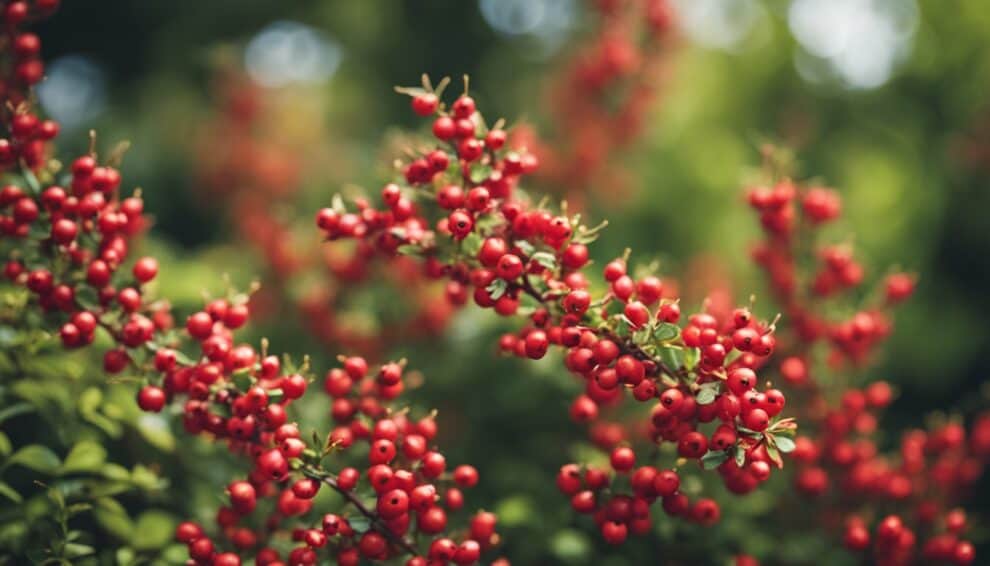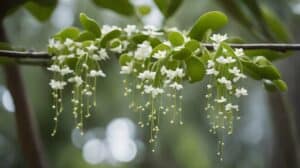Berberis thunbergii, commonly known as the Japanese Barberry, is a deciduous shrub that is native to Japan.
It is a popular ornamental plant that is commonly found in gardens and landscapes across the United States.
However, this plant has become a major problem due to its invasive nature.
The Japanese Barberry has the ability to spread rapidly and outcompete native plant species, leading to significant ecological and economic impacts.

The Japanese Barberry was first introduced to the United States in the late 1800s as an ornamental plant.
Its popularity grew quickly due to its attractive foliage and bright red berries.
However, it was not until the 1960s that the plant began to spread rapidly and become a major problem.
Today, the Japanese Barberry is considered one of the most invasive plant species in the United States, and efforts are being made to control its spread.
Origins and Characteristics of Berberis Thunbergii
Berberis Thunbergii, commonly known as Japanese Barberry, is a deciduous shrub that is native to Japan, China, and Korea.
It was introduced to North America in the late 1800s as an ornamental plant and has since become a popular choice for landscaping due to its vibrant foliage and low maintenance requirements.
The shrub typically grows to a height of 3-6 feet and spreads out to a width of 4-7 feet.
Its leaves are small and oval-shaped, with a glossy texture and serrated edges.
During the spring and summer months, the leaves are a bright green color, but they turn to shades of red, orange, and yellow in the fall.
One of the most distinctive features of Berberis Thunbergii is its thorns. The shrub produces long, sharp thorns that can grow up to half an inch in length.
These thorns serve as a natural defense mechanism against herbivores and can make pruning and maintenance a bit challenging.
In addition to its aesthetic appeal, Berberis Thunbergii has been used for medicinal purposes in traditional Chinese medicine.
Its roots and bark contain compounds that have been shown to have anti-inflammatory and anti-bacterial properties.
Overall, Berberis Thunbergii is a hardy and versatile shrub that can thrive in a variety of conditions.
Its unique characteristics make it a popular choice for gardeners, but it is important to be aware of its invasive tendencies and to take steps to prevent it from spreading to natural areas.
Ecological Impact of Japanese Barberry

Japanese Barberry, also known as Berberis thunbergii, is a popular ornamental shrub that has become invasive in many parts of the world.
While it was originally introduced to North America in the late 1800s for its attractive foliage and bright red berries, it has since spread rapidly and is now considered a significant threat to native plant communities.
One of the main ecological impacts of Japanese Barberry is its ability to outcompete and displace native plant species.
The shrub is particularly well adapted to disturbed areas, such as forest edges, where it can quickly establish itself and create dense thickets that shade out other plants.
This can lead to a loss of biodiversity and a reduction in the overall health of the ecosystem.
Another concern is that Japanese Barberry is a known host for the black-legged tick, which is responsible for transmitting Lyme disease.
The shrub provides an ideal habitat for the tick, as it provides both food and shelter.
As a result, areas with high densities of Japanese Barberry have been found to have higher rates of tick-borne illness.
In addition, Japanese Barberry can alter soil chemistry and nutrient cycling, which can have further impacts on ecosystem health.
The shrub’s shallow root system can deplete soil moisture and nutrients, making it difficult for other plants to grow.
This can lead to soil erosion and reduced water quality, as well as changes in the composition of soil microorganisms.
Overall, the ecological impact of Japanese Barberry is significant and has led to efforts to control its spread.
While the shrub may be attractive and easy to grow, it is important for gardeners and landscapers to choose alternative plants that are not invasive and do not pose a threat to native ecosystems.
Cultivation and Uses in Gardens

Berberis thunbergii, commonly known as the Japanese Barberry, is a popular ornamental plant in gardens due to its attractive foliage and easy cultivation.
This deciduous shrub is native to Japan and was introduced to the United States in the late 1800s.
The Japanese Barberry is a hardy plant that can grow in a variety of soil types and light conditions.
It prefers well-drained soil and full sun, but can also tolerate partial shade.
It is also drought-resistant, making it a low-maintenance plant for gardeners.
The plant is often used as a hedge or border plant due to its dense growth habit and thorny branches, which provide an effective barrier against intruders.
It can also be used as a specimen plant or in mixed borders, where its vibrant foliage can add interest and contrast to the landscape.
The leaves of the Japanese Barberry are small and oval-shaped, with a glossy texture and bright green color in the summer.
In the fall, the leaves turn a vibrant shade of red, adding a burst of color to the garden.
The plant also produces small, bright red berries in the fall, which can be attractive to birds.
Overall, the Japanese Barberry is a versatile and attractive plant that can add interest and beauty to any garden.
However, it is important to note that it is an invasive species in many areas and can cause ecological damage if not properly managed.
Gardeners should consult with local authorities to determine if the Japanese Barberry is a suitable plant for their area.
Management and Control Strategies

Once the Japanese barberry has established itself in a garden, it can be challenging to remove completely.
Therefore, prevention is the best strategy to manage this invasive species. The following are some management and control strategies that can be employed:
Physical Control
Physical control methods include hand-pulling, cutting, mowing, and digging. These methods are most effective on small infestations.
Hand-pulling is most effective when the soil is moist, and the plant is young. Cutting the plant at the base and removing the stems can also be effective.
However, cutting alone will not prevent the plant from resprouting.
Chemical Control
Chemical control methods include the use of herbicides. Glyphosate and triclopyr are effective herbicides for controlling Japanese barberry.
Glyphosate is a non-selective herbicide that kills all plants, while triclopyr is selective and only kills broadleaf plants.
Herbicides should be applied in the fall when the plant is actively growing, and the leaves are still green.
Cultural Control
Cultural control methods include planting alternative species that are not invasive.
These species should be native to the area and should be able to compete with the Japanese barberry.
Additionally, maintaining a healthy and diverse ecosystem can help prevent the establishment of invasive species.
Biological Control
Biological control methods involve the use of natural enemies to control the invasive species.
However, there are currently no biological control agents available for Japanese barberry.
In conclusion, managing and controlling Japanese barberry requires a combination of physical, chemical, cultural, and biological control methods.
Prevention is the best strategy, and early detection and rapid response are essential for successful management.
Frequently Asked Questions

What are the common ways to manage or control Japanese Barberry in gardens?
The most common ways to manage or control Japanese Barberry in gardens are manual removal, chemical control, and prevention.
Hand pulling or digging out the plant is effective but can be time-consuming.
Chemical control involves using herbicides, but caution should be taken to avoid harming other plants and wildlife.
Prevention involves not planting Japanese Barberry in the first place and removing any seedlings that appear.
How can I identify Japanese Barberry compared to other similar plants?
Japanese Barberry can be identified by its spiny stems, small oval leaves with serrated edges, and bright red berries.
It is often confused with other plants such as American Barberry and European Barberry, but the Japanese variety has more spines and smaller leaves.
What are the ecological impacts of Japanese Barberry becoming invasive?
Japanese Barberry can have negative ecological impacts when it becomes invasive.
It outcompetes native plants, reduces biodiversity, and alters soil chemistry.
This can lead to a decline in native wildlife and an increase in pests and diseases.
Are there any safe and effective herbicides for Japanese Barberry?
Yes, there are herbicides that can effectively control Japanese Barberry.
However, it is important to use them safely and according to the label instructions to avoid harming other plants and wildlife.
How does Japanese Barberry affect local wildlife and biodiversity?
Japanese Barberry can negatively affect local wildlife and biodiversity by reducing habitat and food sources for native species.
It can also provide a habitat for ticks, which can carry Lyme disease.
Can Japanese Barberry be used in landscaping, and what are the best practices?
While Japanese Barberry can be used in landscaping, it is not recommended due to its invasive nature.
If it must be used, it should be planted in a contained area and monitored closely to prevent it from spreading.
Best practices include removing any seedlings, avoiding planting near natural areas, and not planting in areas prone to flooding.














